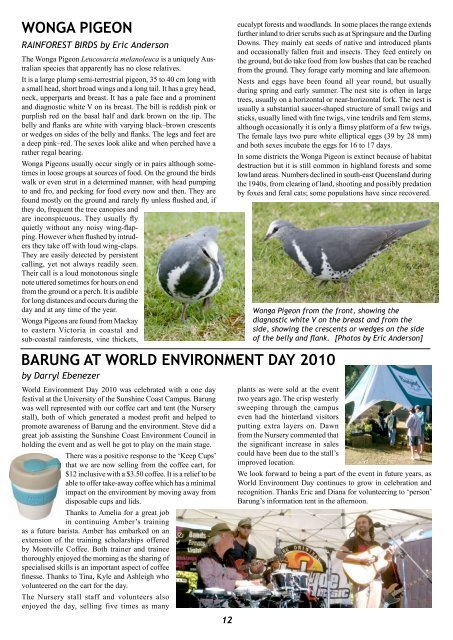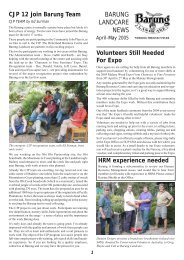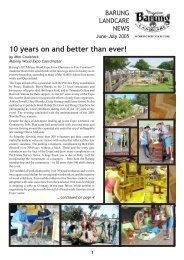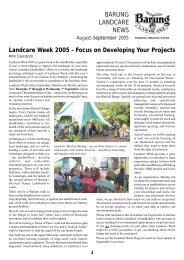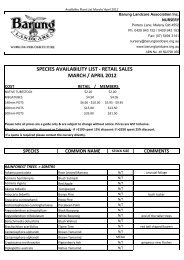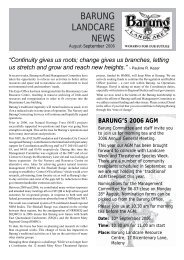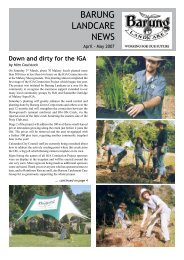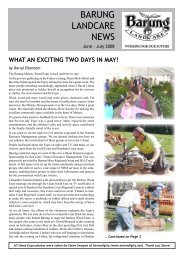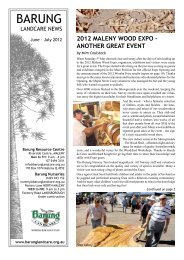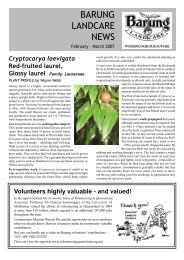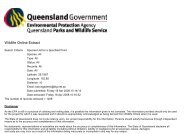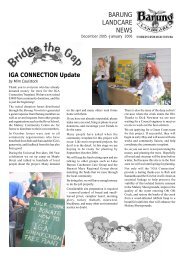Jun/Jul 2010 - Barung Landcare
Jun/Jul 2010 - Barung Landcare
Jun/Jul 2010 - Barung Landcare
Create successful ePaper yourself
Turn your PDF publications into a flip-book with our unique Google optimized e-Paper software.
WONGA PIGEON<br />
RAINFOREST BIRDS by Eric Anderson<br />
The Wonga Pigeon Leucosarcia melanoleuca is a uniquely Australian<br />
species that apparently has no close relatives.<br />
It is a large plump semi-terrestrial pigeon, 35 to 40 cm long with<br />
a small head, short broad wings and a long tail. It has a grey head,<br />
neck, upperparts and breast. It has a pale face and a prominent<br />
and diagnostic white V on its breast. The bill is reddish pink or<br />
purplish red on the basal half and dark brown on the tip. The<br />
belly and flanks are white with varying black–brown crescents<br />
or wedges on sides of the belly and flanks. The legs and feet are<br />
a deep pink–red. The sexes look alike and when perched have a<br />
rather regal bearing.<br />
Wonga Pigeons usually occur singly or in pairs although sometimes<br />
in loose groups at sources of food. On the ground the birds<br />
walk or even strut in a determined manner, with head pumping<br />
to and fro, and pecking for food every now and then. They are<br />
found mostly on the ground and rarely fly unless flushed and, if<br />
they do, frequent the tree canopies and<br />
are inconspicuous. They usually fly<br />
quietly without any noisy wing-flapping.<br />
However when flushed by intruders<br />
they take off with loud wing-claps.<br />
They are easily detected by persistent<br />
calling, yet not always readily seen.<br />
Their call is a loud monotonous single<br />
note uttered sometimes for hours on end<br />
from the ground or a perch. It is audible<br />
for long distances and occurs during the<br />
day and at any time of the year.<br />
Wonga Pigeons are found from Mackay<br />
to eastern Victoria in coastal and<br />
sub-coastal rainforests, vine thickets,<br />
BARUNG AT WORLD ENVIRONMENT DAY <strong>2010</strong><br />
by Darryl Ebenezer<br />
World Environment Day <strong>2010</strong> was celebrated with a one day<br />
festival at the University of the Sunshine Coast Campus. <strong>Barung</strong><br />
was well represented with our coffee cart and tent (the Nursery<br />
stall), both of which generated a modest profit and helped to<br />
promote awareness of <strong>Barung</strong> and the environment. Steve did a<br />
great job assisting the Sunshine Coast Environment Council in<br />
holding the event and as well he got to play on the main stage.<br />
There was a positive response to the ‘Keep Cups’<br />
that we are now selling from the coffee cart, for<br />
$12 inclusive with a $3.50 coffee. It is a relief to be<br />
able to offer take-away coffee which has a minimal<br />
impact on the environment by moving away from<br />
disposable cups and lids.<br />
Thanks to Amelia for a great job<br />
in continuing Amber’s training<br />
as a future barista. Amber has embarked on an<br />
extension of the training scholarships offered<br />
by Montville Coffee. Both trainer and trainee<br />
thoroughly enjoyed the morning as the sharing of<br />
specialised skills is an important aspect of coffee<br />
finesse. Thanks to Tina, Kyle and Ashleigh who<br />
volunteered on the cart for the day.<br />
The Nursery stall staff and volunteers also<br />
enjoyed the day, selling five times as many<br />
12<br />
eucalypt forests and woodlands. In some places the range extends<br />
further inland to drier scrubs such as at Springsure and the Darling<br />
Downs. They mainly eat seeds of native and introduced plants<br />
and occasionally fallen fruit and insects. They feed entirely on<br />
the ground, but do take food from low bushes that can be reached<br />
from the ground. They forage early morning and late afternoon.<br />
Nests and eggs have been found all year round, but usually<br />
during spring and early summer. The nest site is often in large<br />
trees, usually on a horizontal or near-horizontal fork. The nest is<br />
usually a substantial saucer-shaped structure of small twigs and<br />
sticks, usually lined with fine twigs, vine tendrils and fern stems,<br />
although occasionally it is only a flimsy platform of a few twigs.<br />
The female lays two pure white elliptical eggs (39 by 28 mm)<br />
and both sexes incubate the eggs for 16 to 17 days.<br />
In some districts the Wonga Pigeon is extinct because of habitat<br />
destruction but it is still common in highland forests and some<br />
lowland areas. Numbers declined in south-east Queensland during<br />
the 1940s, from clearing of land, shooting and possibly predation<br />
by foxes and feral cats; some populations have since recovered.<br />
Wonga Pigeon from the front, showing the<br />
diagnostic white V on the breast and from the<br />
side, showing the crescents or wedges on the side<br />
of the belly and flank. [Photos by Eric Anderson]<br />
plants as were sold at the event<br />
two years ago. The crisp westerly<br />
sweeping through the campus<br />
even had the hinterland visitors<br />
putting extra layers on. Dawn<br />
from the Nursery commented that<br />
the significant increase in sales<br />
could have been due to the stall’s<br />
improved location.<br />
We look forward to being a part of the event in future years, as<br />
World Environment Day continues to grow in celebration and<br />
recognition. Thanks Eric and Diana for volunteering to ‘person’<br />
<strong>Barung</strong>’s information tent in the afternoon.


